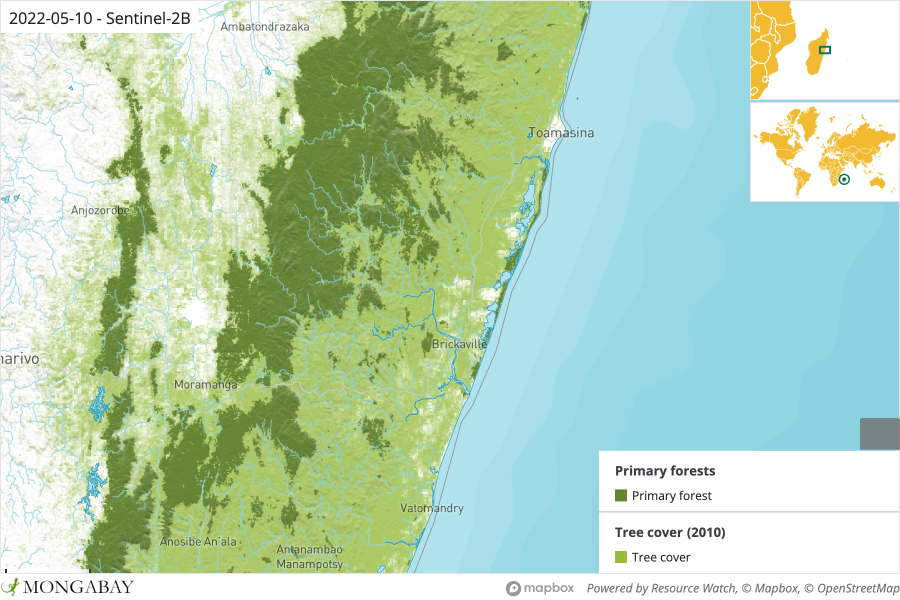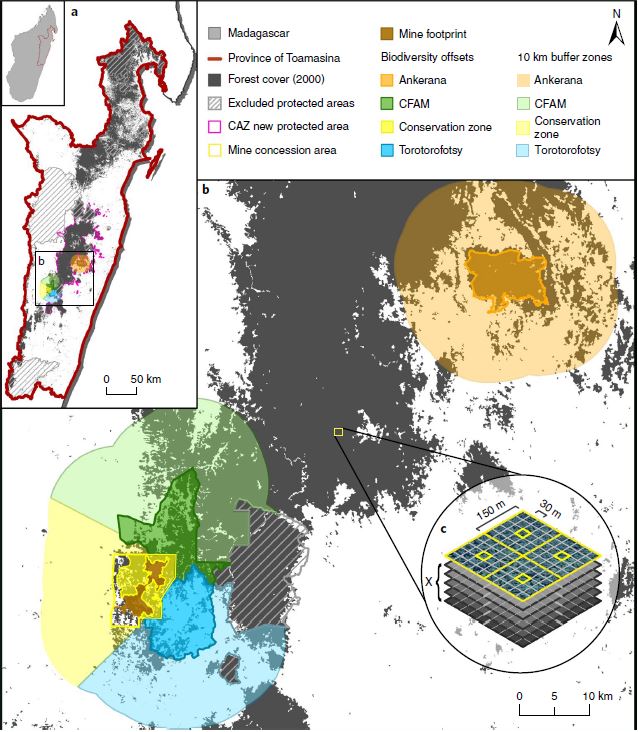- The Ambatovy mine in Madagascar achieved no net forest loss by curbing deforestation in its biodiversity offsets, an analysis in the journal Nature Sustainability concluded.
- Project developers create biodiversity offsets, sites where they undertake conservation work, to make up for environmental destruction caused by their extractive operations.
- Ambatovy, which operates an open-pit nickel mine in Madagascar, carved out four biodiversity offsets to make up for biodiversity loss in its mining site, located in the species-rich eastern rainforest of the island nation.
- By slowing deforestation in these four offsets, the mine made up for forest loss in its mining concession; however, there isn’t enough data to ascertain how the measures impacted biodiversity, and previous research indicates that the mine’s offsets reduced impoverished communities’ access to forest resources.
The Ambatovy nickel mine located in a biodiversity-rich Madagascar rainforest made up for the forest lost due to its operation, a recent study in Nature Sustainability concluded. The mine operators did so by reducing deforestation rates in nearby areas designated as “biodiversity offsets.”
There are at least 6,000 large mining projects that impinge on forests globally. Together, they impact about a tenth of the world’s forests. Project developers establish biodiversity offsets to make up for the environmental destruction caused by their extractive operations, either voluntarily or as a condition of their license to operate. Today, around 12,000 such offsets exist, but there is very little published research on how effective they are.
“These findings are hugely significant,” said Joseph Bull, a conservation scientist at the University of Kent who was not involved in the study.
“Biodiversity offsets and the mitigation hierarchy more generally, have become one of the most influential global conservation approaches — globally — in recent years,” he said. “However, there are very few peer-reviewed empirical analyses of the outcomes of biodiversity offsetting.”
Experts such as Bull say the findings are robust, but warn against considering them a stamp of approval for offsetting in general. If anything, “it is evidence of just how hard you have to work to make offsetting work,” said Sophus zu Ermgassen, an ecological economist at the University of Kent who was not involved in the study.

The tropical rainforests along Madagascar’s eastern coast are some of the most biodiversity-rich areas on the planet. Ambatovy’s mining site sits at the southern end of a large rainforest block. In its vicinity lie the Ankeniheny-Zahamena forest corridor, the Torotorofotsy Ramsar wetland, and Mantadia National Park. About 10% of Madagascar’s known floral diversity is found in these forests alone, including an astonishing 250 orchid species. They are also home to 14 species of Madagascar’s unique primates, lemurs.
Ambatovy operates an open-pit mine near the central-eastern city of Moramanga. The mine connects to processing facilities in the coastal city of Tamatav or Toamasina via a 220-kilometer (136-mile) pipeline. Its current owners are Japan’s Sumitomo Corporation and the Korea Mine Rehabilitation and Mineral Resources Corp. The Malagasy government granted the company a 40-year environmental permit in 2006. The mine started operations in 2014 and is the largest foreign investment in the African island nation. It produces 60,000 metric tons of refined nickel and 5,600 metric tons of refined cobalt annually.
Ambatovy shut down for a year during the COVID-19 pandemic and resumed operations in March 2021.
Since the mine received funding from the World Bank’s International Finance Corporation (IFC), it also adheres to the IFC’s performance standards, which promote the use of the mitigation hierarchy approach to managing environmental and social risks. This is a framework that prioritizes actions from the preventive to the remedial. Companies must avoid negatively impacting the natural environment as far as possible. If they do cause impacts, then they must try and undo the harm. After exhausting these possibilities, they must compensate for the unavoidable, irreparable damage; offsetting is one of these compensatory measures.
The IFC uses the standards to evaluate investments, but doesn’t outright disqualify companies that fail to meet them.
Ambatovy’s mining operation would lead to the destruction of 2,064 hectares (5,100 acres) of natural forests within its concession, according to the company. Ambatovy carved out four offsets, which cover an area of almost 28,740 hectares (about 71,000 acres). One of the offsets lies within the mining concession. Another encompasses the Torotorofotsy wetland east of the concession. A third is a parcel of the Ankeniheny-Zahamena forest block on the northern edge of the mining site. The fourth, the Ankerana offset, lies further north within Ankeniheny-Zahamena.

Logging, slash-and-burn agriculture, and uncontrolled bushfires cause the most damage to rainforests in this region. Madagascar as a whole suffers from high deforestation rates. The country lost 44% of its natural forest cover between 1953 and 2014. Ambatovy partnered with and funded international NGOs and local groups to slow biodiversity losses in the offsets to make up for habitat destruction at its mining site.
In the case of Ankerana, the mine does this in two ways: first, by clamping down on activities like slash-and-burn agriculture, gold mining and logging. The company and the NGOs it funds do so by employing villagers to conduct patrols and at times call in the local police to enforce regulations.
Second, the strategy includes making other economic activities more attractive, like improving agricultural and livestock yields by providing farmers with seeds and fertilizer, better irrigation facilities, and training.
The new paper took into account deforestation rates that existed before the offsets were established and developed a counterfactual, a model for what would have happened if the offsets didn’t exist. It allowed the team, comprising researchers from Bangor University and Rothamsted Research in the U.K. and the University of Montpellier in France, to estimate how much deforestation was avoided thanks to the biodiversity offsets. The paper attributed the avoided deforestation to the mine’s conservation activities in these calculations.
The analysis concluded that Ambatovy had saved enough forests in the offsets by the end of 2021 to claim no net forest loss. Ankerana and the conservation zone within the mining concession saw the greatest protective benefits of the four offset sites. The authors conducted several statistical tests to check the robustness of their findings, said Amrei Von Hase, an expert in biodiversity offsetting. She served as science lead for Forest Trends’ Business and Biodiversity Offsets Programme (BBOP) for 10 years before leaving the Washington, D.C.-based nonprofit.

Ambatovy was a member of the BBOP, which brings together private companies, governments, conservation organizations and financial institutions. The program is aimed at helping develop voluntary standards for offsets and promoting best practices.
Von Hase, who now works with the Wildlife Conservation Society, said one of the concerns with offsetting is the spillover of deforestation to nearby areas, known as leakage. The authors incorporated this in their assessment by tracking deforestation within a 10-km (6.2-mi) radius of the offsets and did not find leakages.
One of the biggest drawbacks of the analysis is that it relies on forest cover as an “imperfect proxy” for biodiversity, the paper says; the authors did not consider the fate of individual species. Also, the gains the study documented do not indicate that forest cover increased. They only show that deforestation was slower than it might have been without the offsets in place.
For Ankerana, the success in keeping forests standing could be a result of restricting access to the forest, the study suggested.
A previous study co-authored in 2017 by Julia P. Jones, a conservation scientist at Bangor University who is also a co-author of the new paper, investigated residents’ perceptions of the Ankerana offset. Respondents said they believed they had suffered a “net cost” because of the offset’s creation. “Offsetting when aimed at slowing forest losses due to, for example, swidden agriculture practiced by local communities in Madagascar can mean that poor, marginalized people bear the biggest burden of increased forest protection,” Von Hase said.
Like other conservation measures, biodiversity offsets restrict people’s access to resources they have long exploited, ideally providing more sustainable alternatives. Unlike communities who are displaced and impacted by the actual mining site, people who lose access to resources because of biodiversity offsets are not considered “impacted” under the International Finance Corporation’s widely used performance standard 6. Since the mine may be located far from the offset, communities who are impacted by offsetting may not even benefit from the mine’s presence, for example, through jobs or better transportation infrastructure.
The available evidence doesn’t explain why Ambatovy achieved no net forest loss. The authors speculate that it could be because the offsetting strategy is focused on capturing measurable impacts. What’s more, big companies with deep pockets can invest substantial money into achieving this goal.
“One of the key concerns with offsetting elsewhere is that projects often receive insufficient resources and, as a result, are not implemented properly,” Bull said. “No matter how well-designed offsets are on paper, they will never work if they are not properly resourced, monitored, and enforced.”
It also remains to be seen if Ambatovy’s gains will last, especially after the company wraps up operations some time between 2040 and 2050 and the owners decamp from Madagascar. What is encouraging, according to the paper’s authors, is that the Ankerana and Torotorofotsy offsets are now part of Madagascar’s network of national protected areas, and another of Ambatovy’s offsets could join, ensuring longer-term protection.
Banner image: A diademed sifaka (Propithecus diadema) in Madagascar’s tropical rainforests. Image by Rhett A. Butler.
Citations:
Devenish, K., Desbureaux, S., Willcock, S., & Jones, J. P. (2022). On track to achieve no net loss of forest at Madagascar’s biggest mine. Nature Sustainability. doi:10.1038/s41893-022-00850-7
Grimm, M., & Köppel, J. (2019). Biodiversity offset program design and implementation. Sustainability, 11(24), 6903. doi:10.3390/su11246903
Ten Kate, K., Von Hase, A., & Maguire, P. (2018). Principles of the business and biodiversity offsets programme. Biodiversity Offsets, 17-26. doi:10.1007/978-3-319-72581-9_3
Bidaud, C., Schreckenberg, K., Rabeharison, M., Ranjatson, P., Gibbons, J., & Jones, J. P. G. (2017). The sweet and the bitter: Intertwined positive and negative social impacts of a biodiversity offset. Conservation and Society, 15(1), 1-13. doi:10.4103/0972-4923.196315














